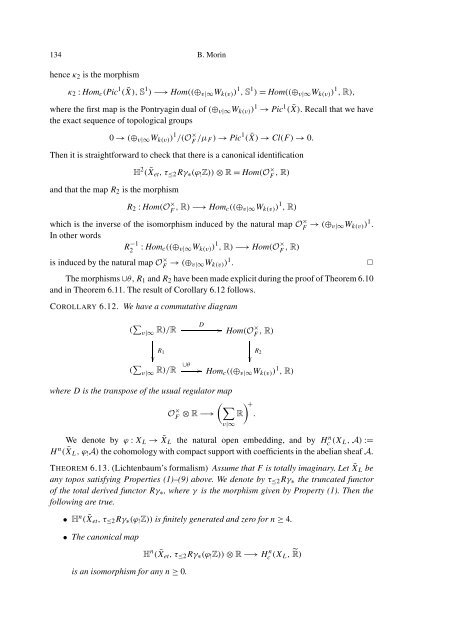THE WEIL-´ETALE FUNDAMENTAL GROUP OF A NUMBER FIELD I
THE WEIL-´ETALE FUNDAMENTAL GROUP OF A NUMBER FIELD I
THE WEIL-´ETALE FUNDAMENTAL GROUP OF A NUMBER FIELD I
Create successful ePaper yourself
Turn your PDF publications into a flip-book with our unique Google optimized e-Paper software.
134 B. Morin<br />
hence κ 2 is the morphism<br />
κ 2 : Hom c (Pic 1 ( ¯X), S 1 ) −→ Hom((⊕ v|∞ W k(v) ) 1 , S 1 ) = Hom((⊕ v|∞ W k(v) ) 1 , R),<br />
where the first map is the Pontryagin dual of (⊕ v|∞ W k(v) ) 1 → Pic 1 ( ¯X). Recall that we have<br />
the exact sequence of topological groups<br />
0 → (⊕ v|∞ W k(v) ) 1 /(O × F /μ F ) → Pic 1 ( ¯X) → Cl(F ) → 0.<br />
Then it is straightforward to check that there is a canonical identification<br />
and that the map R 2 is the morphism<br />
H 2 ( ¯X et ,τ ≤2 Rγ ∗ (ϕ ! Z)) ⊗ R = Hom(O × F , R)<br />
R 2 : Hom(O × F , R) −→ Hom c((⊕ v|∞ W k(v) ) 1 , R)<br />
which is the inverse of the isomorphism induced by the natural map O<br />
F × → (⊕ v|∞W k(v) ) 1 .<br />
In other words<br />
R2 −1 : Hom c ((⊕ v|∞ W k(v) ) 1 , R) −→ Hom(O<br />
F × , R)<br />
is induced by the natural map O<br />
F × → (⊕ v|∞W k(v) ) 1 .<br />
✷<br />
The morphisms ∪θ, R 1 and R 2 have been made explicit during the proof of Theorem 6.10<br />
and in Theorem 6.11. The result of Corollary 6.12 follows.<br />
COROLLARY 6.12. We have a commutative diagram<br />
( ∑ v|∞ R)/R D<br />
Hom(O<br />
F × , R)<br />
R 1<br />
R 2<br />
<br />
<br />
( ∑ v|∞ R)/R ∪θ Homc ((⊕ v|∞ W k(v) ) 1 , R)<br />
where D is the transpose of the usual regulator map<br />
O × F ⊗ R −→ ( ∑<br />
v|∞<br />
R) +<br />
.<br />
We denote by ϕ : X L → ¯X L the natural open embedding, and by H n c (X L, A) :=<br />
H n ( ¯X L ,ϕ ! A) the cohomology with compact support with coefficients in the abelian sheaf A.<br />
<strong>THE</strong>OREM 6.13. (Lichtenbaum’s formalism) Assume that F is totally imaginary. Let ¯X L be<br />
any topos satisfying Properties (1)–(9) above. We denote by τ ≤2 Rγ ∗ the truncated functor<br />
of the total derived functor Rγ ∗ ,whereγ is the morphism given by Property (1). Then the<br />
following are true.<br />
• H n ( ¯X et ,τ ≤2 Rγ ∗ (ϕ ! Z)) is finitely generated and zero for n ≥ 4.<br />
• The canonical map<br />
is an isomorphism for any n ≥ 0.<br />
H n ( ¯X et ,τ ≤2 Rγ ∗ (ϕ ! Z)) ⊗ R −→ H n c (X L, ˜R)

















